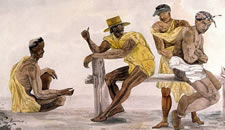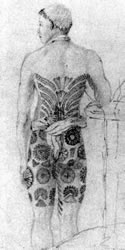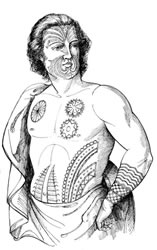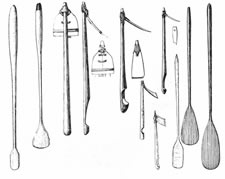Embodied Symbols of the South Seas: Eastern Oceania
Article © 2010 Lars Krutak
Tahiti
 |
|
Tattooed Inhabitants of Tahiti, 1823. |
As in Tonga, the disintegration of traditional tattooing culture in Tahiti was the result of missionization and the banning of the practice as early as 1819 in some of the islands. The British missionary Ellis writing in the 1830s reported, "the simple act of tatuing or marking the skin, was in itself no breach of the peace, but it was connected with their former idolatry, and always attended with the practices of abominable vices, and on this account was prohibited."
He continued, "On account of the immoral practices invariably connected with the process of tatauing, the [Christian] chiefs prohibited it altogether, and, excepting a few foreign seamen, who often evinced as great a desire to have some figure tatued on their arms or hands, as the natives themselves, there had not been an individual marked for some years."
Missionaries enforced the tattooing ban with extreme acts like forcibly tattooing "criminal" marks upon the hands and faces of men and women who continued their ancestral customs, and in extreme cases they even flayed or skinned native Tahitians (Moahi) to remove their indelible markings.
Apart from such horrid and unthinkable forms of punishment, some tattoo practitioners were also forced into solitary confinement: "[O]n the island of Raiatea, two deep pits were once dug on the side of a hill; each was about fifteen feet deep, and was smaller at the top than at the bottom, so that it appeared impossible to climb up the sides. A woman who had run away from her husband and got herself tattooed, was put in one of these pits, and the man who tattooed her in the other."
Evidently, the missionaries' influence had a profound effect on Tahitian tattooing tradition, and by the 1850s published reports proclaimed that "The art is much lost, for the missionaries have discouraged it; but there are a few even now that are not marked, though all knowledge of the mysterious arrangement of it and of the different sorts, to each class, is now lost." Writing in 1853, the Frenchman Berchon echoed a similar sentiment when he observed that, "We had much difficulty in finding the tatu arches printed on the buttocks, loins and sides of the abdomen up to the false ribs, which made the women of Tahiti so proud in the time of Cook." Of course, these developments also had a negative impact on the visual record of Tahitian tattooing itself, since there are fewer than twenty known illustrations of authentic Moahi tattoos today.
First Encounters
The naturalist Joseph Banks, who traveled with Cook on his first voyage to the South Pacific, provides perhaps the earliest (1769) account of Tahitian tattooing:
every one is marked thus in different parts of his body according may be to his humour or different circumstances of his life. Some have ill designd figures of men, birds or dogs, but they more generaly have this figure Z either simply, as the women are generaly markd with it,on every joint of their fingers and toes and often round the outside of their feet, or in different figures and toes and often round the outside of their feet, or in different figures of it as square, circles, crescents &c. which both sexes have on their arms and leggs; in short they have an infinite diversity of figures in which they place this mark and some of them we were told had significations but this we never learnt to our satisfaction. Their faces are in general left without marks, I did not see more than one instance to the contrary.
Although Banks and his contemporaries did not completely understand the significance and symbolism of such designs, he continued his account with more important information:
all the Islanders I have seen agree in having all their buttocks coverd with a deep black; over this most have arches drawn one over another as high as their short ribbs; which are often 1/4 of an inch broad and neatly workd on their edges with indentations &c. These arches are their great pride: both men and women shew them with great pleasure whether as a beauty or a proof of their perseverance and resolution in bearing pain I can not tell.

Tahitian tattoos sketched by Sydney Parkinson, 1769. |
The illustrator Sydney Parkinson, who received a tattoo during his three month stay in Tahiti with the Cook expedition, created a sketch of these "arches". This drawing (1769) is significant because it is the first European image of Polynesian tattooing itself.
Banks, however, also detailed the actual process of tattooing upon the skin of a young Tahitian girl. He recorded the local term for the custom (tatau or tattow), a word that has been borrowed many times over to describe the contemporary art form that is ultimately derived from tribal Polynesian origins.
This morn I saw the operation of Tattowing the buttocks performd upon a girl of about 12 years old, it provd as I have always suspected a most painfull one. It was done with a large instrument about 2 inches long containing about 30 teeth, every stroke of this hundreds of which were made in a minute drew blood. The patient bore this for about 1/4 of an hour with most stoical resolution; by that time however the pain began to operate too stron[g]ly to be peacably endurd, she began to complain and soon burst out into loud lamentations... The arches upon the loins upon which they value themselves much were not yet done, the doing of which they told causd more pain than what I had seen.
Georg Forster, an ethnologist who traveled with Cook to Tahiti during his second voyage, provided still more details including local terms that allow us to partially reconstruct the symbolism that these designs were probably meant to convey.
The arches which they design on their buttocks obtain the name of avaree; the parts on which are one mass of black on the buttocks are named toumarro [girdle of spears], and the arches which are thus designed on the buttocks of their females, and are honourable marks of their puberty are called toto-hoowa.
Symbolic Meanings
From the Tahitian terms provided by Forster, several symbolic distinctions can be made. But before these are explored in more detail, one must remember that Polynesian art is polysemous or marked by a multiplicity of layered meanings. These layers are usually veiled in a system of interrelationships between symbolic opposites (e.g., life and death, darkness and light, impermanence and permanence, etc.) that both accounted for and regulated the positive and negative forces held responsible for the origins of the Polynesian universe and the act of human creation, among other things.
In Tahiti, for example, newborns were characterized by a certain amount of tapu or contagious dangerousness because they emerged from the darkness of the mother's womb which was associated with the po, or the realm of the divine. Owing to their inherited godliness of recently being given life by the divine, infants were highly tapu and their contagiousness had to be diffused in order for others to interact safely with them. In fact, everything that came into contact with the newborn, including its parents' food, was also tapu, and if the proper ceremonial protocols were not initiated divine retribution was certain. |

Rear view of a Tahitian man with elaborate tattooing, 1826. |
 The Englishman John Rutherford with Tahitian torso designs, 1828. |
To remove this state of taboo, a series of rituals called amo'a or "head-releasing" rites were set into motion. These ceremonies took place periodically until the child had matured, and were initiated with the removal of blood from the infant's head. This body part was significant in Polynesian culture because the head was considered to be the most tapu part of the body; as it was the primary seat and site of a person's mana.
The blood was removed with a shark's tooth attached to a special stick, and was wielded by the parents and relatives of the tabooed child. It was collected and mixed with sugarcane and placed on a leaf of miro or rosewood (used in contexts of communication with the gods) or on a tapa cloth. The sacred mixture was offered first to the child, and then to the gods. This ceremonial action ensured the desanctification of the newborn to the extent that objects touched by it were no longer dangerous to other people. It also allowed the infant's parents to feed themselves too.
As the child matured and eventually reached the final stage of the amo'a cycle, s/he received a small tattoo on the inside of each arm, just above the elbow, to "seal off" the body from its tabooed state. This tattoo signaled to all that the rites of amo'a had been completed, and that the child had achieved a level of 'ritual immunity' from its previous condition. This act of "enclosure" with tattoo also moved the child one step closer to its bodily and spiritual "completion," because the mark transported it closer to full adult membership.
But as Forster noted, additional tattoos would come to be applied to the body including beautiful arch-like tattoos that covered the buttocks of men and women. Apparently, women and men were compelled to receive these marks at a very early age and according to Morrison, one of the Bounty mutineers under Fletcher Christian (1789), girls could "never" join the company the adult women "till they have their Tatoowing done."
This statement, amongst other supporting evidence, seems to indicate that a residual level of tapu continued to accompany young Moahi women, and probably men too, and that another layer of tattooing was necessary to permanently diminish the dangerous sacredness of the body and protect others from this malevolent influence. The logic of this conclusion is based on the word that Forster recorded for the "arch" tattoos of Moahi women and men. Avaree means to "raise or lift a taboo," meaning that Moahi who were thus marked could fully interact with adult members of society.
The dense patches of black that adjoined the arch tattoos also seem to have added other protective qualities, or at least enhanced the spiritual power of the adorned. These patterns were called toumarro ("girdle of spears") and probably conveyed the idea of status and accumulated power. This is because across Polynesia the act of wrapping or binding an object or human body with barkcloth or other encapsulating mediums like feathered capes, transported it from an ordinary state (noa) to one with mana. In Tonga and Samoa, for example, wrapping oneself in barkcloth or even weapons like spears with tapa symbolizes this ideological movement.
Tattoo Rebellions
 |
|
Tahitian tattooing tools. |
Because the Moahi art of tattoo was so central to individual and collective concepts of identity, status, maturity and well-being, Tahitians in the face of missionary suppression staged a series of what have been called "tattoo rebellions" in the early to mid nineteenth-century to assert their sovereignty and ancestral ties to the old religion. The leaders of this campaign were comprised of an elite social group of bards, poets, tribal historians, and priests known as the ario'i who possessed extensive socio-political and religious influence because of their dedication to the important deity 'Oro, the god of war.
The ario'i existed as an itinerant society thattravelled around the Tahitian archipelago extracting offerings from the local population for the purpose of mounting large festivals in honor of their patron deity 'Oro. The ario'i were infamous locally not only for their promiscuously flamboyant and bacchanalian pursuits, but also for their rigid adherence to traditional practices like tattooing that served to distinguish particular grades within the organization itself. These grades and accompanying tattoos are as follows:
I. Avae Parai ("blotted legs" or "black legs"). This was the highest grade of the society. Each local branch of the ario'i was headed by a pair of ario'i leaders or "chiefs", one male and one female, who were tattooed in solid black from the foot to the groin.
II. Harotea (light-colored haro tattoo mark). Bars running crosswise on both sides of the body from the armpits downwards towards the front.
III. Taputu or ha'aputu. This design consisted of a series of curved lines and curves radiating upwards towards the sides of the torso from the lower end of the spinal column to the middle of the back.
IV. Oti'ore ("unfinished"). Light marks on the knuckles and wrists, and heavier ones on the arms and shoulders.
V. Hu'a ("small"). Two or three light marks on the shoulders.
VI. Atoro. One stripe down the left side.
VII. Ohe mara ("seasoned bamboo"). A circle tattooed around the ankle.
VIII. Tara tutu ("pointed thorn"). Small marks in the hollow behind the knees.
But to the Christian missionaries operating in the islands, the ario'i were nothing more than parasites feeding off of the hard work of the Moahi commoners. This fact combined with the ario'i's penchant for sexual misconduct and refusal to abandon the "pagan" (and recently outlawed) practice of tattoo solidified the Church's position that these "heathens" presented nothing less than a radical obstacle in their attempts to "civilize" the population.
The missionary John Davies wrote:
many of the young people shewed a strong inclination to return to their former divisions, and marking their bodies with the tatau according to former practice, and tho' this at first took place among those that were not baptized or brought under the discipline of those more immediately under the inspection of the [missionaries], the defection by degrees reached further, and many of the baptized began to associate with those that had returned to those vain and sinful practices.
After the French claimed title and official control of Tahiti in 1842, resistance continued but the subsequent conversion of many chiefs and other indigenous authorities to Christianity, combined with the threat of forced exile to other French colonies, certainly had an effect on pushing the practice underground for many decades to come. In fact, it was not until 1981 that the official Moahi tatau revival began with the assistance of a Samoan tufuga who brought the ancient art back to life.
Next Page | 1 | 2 | 3 | 4 | 5 | 6 | 7 | 8 |
Museum photo gallery of the images
on this page may be seen here. |





